
The X-Group Culture (ca. 300-600 AD) was an ancient Nubian civilization that existed in Lower Nubia. [2] Cemetery excavations revealed that the civilization stretched from the Dodekaschoinos in the north to Delgo in the south.

The X-Group Culture (ca. 300-600 AD) was an ancient Nubian civilization that existed in Lower Nubia. [2] Cemetery excavations revealed that the civilization stretched from the Dodekaschoinos in the north to Delgo in the south.
George A. Reisner coined the term X-Group Culture for lack of a more exact historical definition. [3] This anonymous type of terminology has been replaced by the term Ballana culture due to the increase of knowledge and new findings in Qustul and Ballana as proposed by Bruce Trigger. [4]
According to Egyptologists Keith Seele and Bruce Williams, the burials of X-Group are evidence of an evolution from the earlier Meroitic graves to those at Ballana, which were principally Nubian in origin along with the majority of the items found within them. In one royal tomb, a queen was discovered, accompanied by seventeen human sacrifices. Another royal tomb contained a body of a man who was likely a king, offerings of food and drinks, and his personal items, such as a crown, board game and weapons. [2]

Nubians are a Nilo-Saharan speaking ethnic group indigenous to the region which is now northern Sudan and southern Egypt. They originate from the early inhabitants of the central Nile valley, believed to be one of the earliest cradles of civilization. In the southern valley of Egypt, Nubians differ culturally and ethnically from Egyptians, although they intermarried with members of other ethnic groups, especially Arabs. They speak Nubian languages as a mother tongue, part of the Northern Eastern Sudanic languages, and Arabic as a second language.
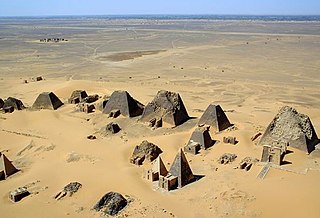
The Nubian pyramids were built by the rulers of the ancient Kushite kingdoms. The area of the Nile valley known as Nubia, which lies in northern present-day Sudan, was the site of three Kushite kingdoms during antiquity. The capital of the first was at Kerma. The second was centered on Napata. The third kingdom was centered on Meroë. The pyramids are built of granite and sandstone.

Kerma was the capital city of the Kerma culture, which was founded in present-day Sudan before 3500 BC. Kerma is one of the largest archaeological sites in ancient Nubia. It has produced decades of extensive excavations and research, including thousands of graves and tombs and the residential quarters of the main city surrounding the Western/Lower Deffufa.

Lower Nubia is the northernmost part of Nubia, roughly contiguous with the modern Lake Nasser, which submerged the historical region in the 1960s with the construction of the Aswan High Dam. Many ancient Lower Nubian monuments, and all its modern population, were relocated as part of the International Campaign to Save the Monuments of Nubia; Qasr Ibrim is the only major archaeological site which was neither relocated nor submerged. The intensive archaeological work conducted prior to the flooding means that the history of the area is much better known than that of Upper Nubia. According to David Wengrow, the A-Group Nubian polity of the late 4th millenninum BCE is poorly understood since most of the archaeological remains are submerged underneath Lake Nasser.

The Kingdom of Kerma or the Kerma culture was an early civilization centered in Kerma, Sudan. It flourished from around 2500 BC to 1500 BC in ancient Nubia. The Kerma culture was based in the southern part of Nubia, or "Upper Nubia", and later extended its reach northward into Lower Nubia and the border of Egypt. The polity seems to have been one of a number of Nile Valley states during the Middle Kingdom of Egypt. In the Kingdom of Kerma's latest phase, lasting from about 1700 to 1500 BC, it absorbed the Sudanese kingdom of Sai and became a sizable, populous empire rivaling Egypt. Around 1500 BC, it was absorbed into the New Kingdom of Egypt, but rebellions continued for centuries. By the eleventh century BC, the more-Egyptianized Kingdom of Kush emerged, possibly from Kerma, and regained the region's independence from Egypt.
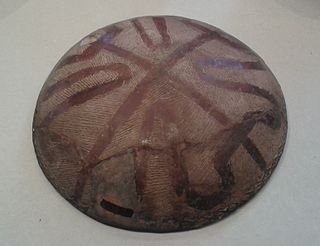
The C-Group culture is an archaeological culture found in Lower Nubia, which dates from c. 2400 BCE to c. 1550 BCE. It was named by George A. Reisner. With no central site and no written evidence about what these people called themselves, Reisner assigned the culture a letter. The C-Group arose after Reisner's A-Group and B-Group cultures, and around the time the Old Kingdom was ending in Ancient Egypt.

Hedjet is the White Crown of pharaonic Upper Egypt. After the unification of Upper and Lower Egypt, it was combined with the Deshret, the Red Crown of Lower Egypt, to form the Pschent, the double crown of Egypt. The symbol sometimes used for the White Crown was the vulture goddess Nekhbet shown next to the head of the cobra goddess Wadjet, the uraeus on the Pschent.

Nobatia or Nobadia was a late antique kingdom in Lower Nubia. Together with the two other Nubian kingdoms, Makuria and Alodia, it succeeded the kingdom of Kush. After its establishment in around 400, Nobadia gradually expanded by defeating the Blemmyes in the north and incorporating the territory between the second and third Nile cataract in the south. In 543, it converted to Coptic Christianity. It would then be annexed by Makuria, under unknown circumstances, during the 7th century.
The A-Group culture was an ancient culture that flourished between the First and Second Cataracts of the Nile in Lower Nubia. It lasted from c. 3800 BC to c. 3100 BC.
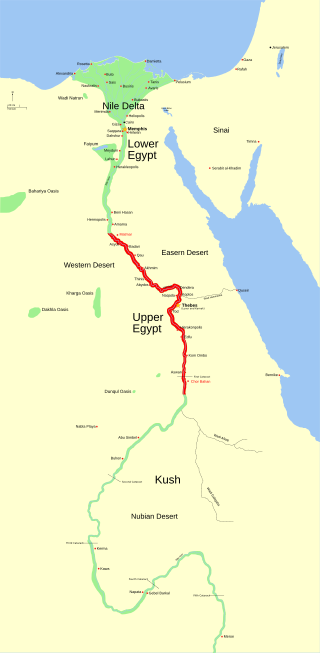
The Naqada culture is an archaeological culture of Chalcolithic Predynastic Egypt, named for the town of Naqada, Qena Governorate. A 2013 Oxford University radiocarbon dating study of the Predynastic period suggests a beginning date sometime between 3,800 and 3,700 BC.
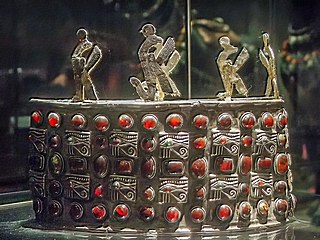
Ballana was a cemetery in Lower Nubia. It, along with nearby Qustul, were excavated by Walter Bryan Emery between 1928 and 1931 as a rescue project before a second rising of the Aswan Low Dam. A total of 122 tombs were found under huge artificial mounds. They date to the time after the collapse of the Meroitic state but before the founding of the Christian Nubian kingdoms, around AD 350 to 600. They usually featured one or several underground chambers, with one main burial chamber. Some tombs were found unlooted, but even the robbed burials still proved to contain many burial goods.
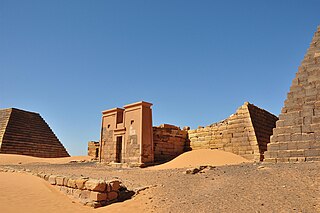
Nubian architecture is diverse and ancient. Permanent villages have been found in Nubia, which date from 6000 BC. These villages were roughly contemporary with the walled town of Jericho in Palestine.

Nubia is a region along the Nile river encompassing the confluence of the Blue and White Niles, and the area between the first cataract of the Nile or more strictly, Al Dabbah. It was the seat of one of the earliest civilizations of ancient Africa, the Kerma culture, which lasted from around 2500 BC until its conquest by the New Kingdom of Egypt under Pharaoh Thutmose I around 1500 BC, whose heirs ruled most of Nubia for the next 400 years. Nubia was home to several empires, most prominently the Kingdom of Kush, which conquered Egypt in the eighth century BC during the reign of Piye and ruled the country as its 25th Dynasty.

The Kingdom of Kush, also known as the Kushite Empire, or simply Kush, was an ancient kingdom in Nubia, centered along the Nile Valley in what is now northern Sudan and southern Egypt.

Egypt has a long and involved demographic history. This is partly due to the territory's geographical location at the crossroads of several major cultural areas: North Africa, the Middle East, the Mediterranean and Sub-Saharan Africa. In addition, Egypt has experienced several invasions and being part of many regional empires during its long history, including by the Canaanites, the Ancient Libyans, the Assyrians, the Kushites, the Persians, the Greeks, the Romans, and the Arabs.

The Tasian culture is possibly one of the oldest-known Predynastic culture in Upper Egypt, which evolved around 4500 BC. It is named for the burials found at Deir Tasa, a site on the east bank of the Nile located between Asyut and Akhmim. There is no general agreement about the proposed "Tasian culture", and some scholars since Baumgartel in 1955 have suggested it is a part of the Badarian culture, rather than a separate entity.
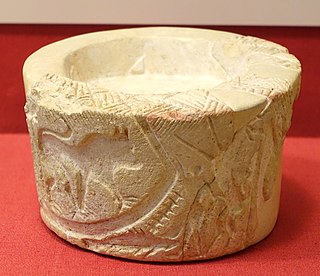
Qustul is an archaeological cemetery located on the eastern bank of the Nile in Lower Nubia, just opposite of Ballana near the Sudan frontier. The site has archaeological records from the A-Group culture, the New Kingdom of Egypt and the X-Group culture.

Nubia is a region along the Nile river encompassing the area between the first cataract of the Nile as well as the confluence of the blue and white Niles or, more strictly, Al Dabbah. Nubia was the seat of several civilizations of ancient Africa, including the Kerma culture, the kingdom of Kush, Nobatia, Makuria and Alodia.

Gebel Adda was a mountain and archaeological site on the right bank of the Nubian Nile in what is now southern Egypt. The settlement on its crest was continuously inhabited from the late Meroitic period to the Ottoman period, when it was abandoned by the late 18th century. It reached its greatest prominence in the 14th and 15th centuries, when it seemed to have been the capital of late kingdom of Makuria. The site was superficially excavated by the American Research Center in Egypt just before being flooded by Lake Nasser in the 1960s, with much of the remaining excavated material, now stored in the Royal Ontario Museum in Canada, remaining unpublished. Unearthed were Meroitic inscriptions, Old Nubian documents, a large amount of leatherwork, two palatial structures and several churches, some of them with their paintings still intact. The nearby ancient Egyptian rock temple of Horemheb, also known as temple of Abu Oda, was rescued and relocated.

Kushite religion is the traditional belief system and pantheon of deities associated with the Ancient Nubians, who founded the Kingdom of Kush in the land of Nubia in present-day Sudan.